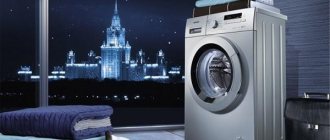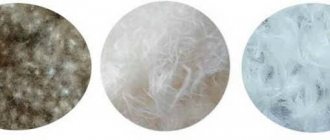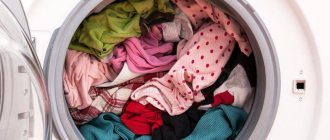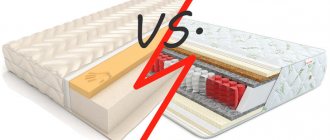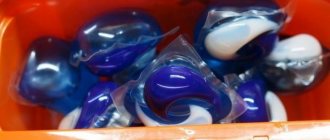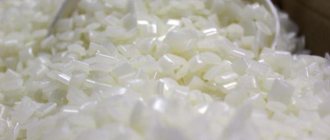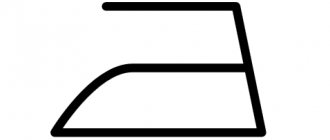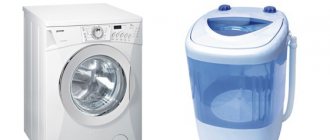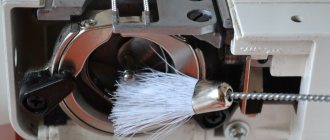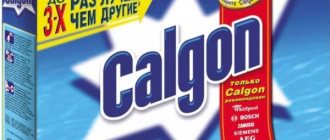Spin classes in the washing machine
Any model, one way or another, allows you to remove not just clean, but also practically dry laundry from the machine. In general, the speed of rotation of the drum affects the dryness of things. The characteristic is calculated in this way: the washing and spinning time is divided by the weight of the laundry being washed and multiplied by 100%.
Varieties of spin classes
There are only 7 spin classes and they are designated by Latin letters. At the moment, it is customary for manufacturers to mark only 4 classes - A, B, C and D.
- “A” – the maximum number of revolutions (more than 1000 times) allows you to get almost dry laundry. The humidity doesn't even reach 50%.
- “B” - the drum rotates up to 1000 rpm, while the humidity of things is 54%.
- “C” – the number of revolutions per minute is 800, therefore, the humidity of the washed laundry varies from 55 to 63%.
- “D” – speed – 400, humidity – from 64 to 72%.
Categories “D” and “G” are more typical for older production models. Modern manufacturers have abandoned these categories due to the fact that washed clothes have to be wrung out by hand.
Of course, the speed of the drum and the quality of the dried products are interconnected. For this reason, in machines equipped with categories “A” and “B” the number of revolutions can quite easily fluctuate from 1200 to 2000. A distinctive feature of such models is their impressive dimensions and increased capacity. But the negative side of the process should also be taken into account - the high speed and force with which the laundry is pressed against the walls of the drum are the culprits in the fact that things are too wrinkled.
Every housewife knows that a thing dried due to a large number of turns turns out to be so wrinkled that it requires special moisture before ironing. It turns out that high speeds are not an indicator of high-quality washing. However, the cost of the product also depends on the number of revolutions - such a marketing ploy.
Models that are not particularly wide should be chosen with a minimum number of revolutions - up to 800 and a load of up to 6 kg. The fact is that increased rotation of the drum affects its increased vibration, especially when there is plenty of laundry in the washing machine.
Which one is better to choose?
The answer to the question which spin class is better in a washing machine depends on 2 factors that need to be assessed before making a choice:
- How important is the issue of saving on the energy consumption of the device?
- How often should you wash large and heavy items made of thick fabric?
When making a decision, it should be remembered that spin classes A and B give results that will not be visually different. The high drum speeds required to achieve them will result in the washing machine vibrating heavily.
They can only be used for jeans, bed linen and other similar items. For clothes made of silk or wool, gentle regimes are established. Therefore, for those who rarely use items made of linen and cotton, preferring items made from more delicate fabrics, there is no point in buying a machine with a spin speed of 1200 rpm or more.
Practice shows that to get well-wrung laundry, 800-1000 rpm is enough. This means that category C is optimal for home use. The residual moisture indicator reaches 63%.
Only those who find it difficult or harmful to hang bed linen or other large items to dry should strive for more effective removal of moisture from washed items.
Choosing the most suitable spin class
Almost all modern models include a programmed drying function. To wash your clothes today, all you need to do is sort them, select the appropriate program and press “Start”. Each program already has its own number of revolutions. Each program differs in the acceptable type of clothing.
It is clear that you cannot combine light synthetic fabrics and outerwear together in one wash. Synthetics can easily lose the aesthetics of their appearance, namely these can be hooks, torn sections of the material. In this regard, each fabric requires a certain attitude towards itself under specific conditions.
Cotton
Cotton fabrics require a temperature range of 40-60 degrees for washing. Dark and slightly dusty items are washed at 40 degrees. Products that do not require subsequent ironing, such as blankets and towels, can be washed at maximum speed.
Accordingly, white cotton items are washed at a maximum of 60 degrees. But this temperature regime should be treated with caution - high temperatures can recolor or even change the size (stretch/shrink) of your clothes. You should not set the speed to more than 800 per minute.
Synthetics
It is preferable to wash synthetic clothes at 40 degrees and dry at 400 rpm. In this case, it will not lose its original shape. If the item is heavily soiled, then you should choose a higher temperature.
Delicate cycle/hand wash, wool
Manufacturers usually offer 40 degrees and 800 revolutions in this position. At the same time, very little time is allocated for rinsing, which leads to the fact that some items of clothing may not be rinsed. It should be remembered that in cases where the fabric is light and delicate, it is better to choose the minimum number of revolutions, namely 400, so as not to damage the clothes.
Kids' things
95 degrees and 1200 rpm are preferred. The logical question is why is the temperature so high? - a simple answer is brewing - this is disinfection. As a bonus, products after the presented program do not require additional ironing. But the impact of centrifugal force on them still does not provide a 100% guarantee, because clothes wrinkle.
If you really don’t want to pick up an iron, then you can use the additional “easy ironing” function. Most manufacturers are trying to implement it. I would like to add two words of my own: this is a very convenient function; the laundry can be pulled out of the machine not only clean and fresh, but also even and smooth.
Intensive wash, outerwear
The cycle increases the time available for washing on any set mode. In this case, the spin can be adjusted from 800 to the maximum set number. In simple terms, the laundry comes out wrinkled and crumpled. The optimal number of revolutions is 1000.
Quick wash
A very convenient program for washing lightly soiled small items such as socks, panties, T-shirts, T-shirts.
Summarizing the previous section, it is worth emphasizing that colored items are washed separately from white and dark ones. And in order for your wardrobe not to lose its original appearance, it is best to give preference to a temperature of 40 degrees.
Advice for those who are just buying an automatic machine! Masters specializing in this field recommend purchasing equipment of this kind only from Italian or German assembly, which in itself is a guarantee of a long service life. A very important point - Italian/German equipment assembled in Russia or China breaks down more often than equipment assembled in the manufacturer’s homeland.
Looking for pros and cons
From the characteristics it is clear that class A allows you to take clothes out of the washing machine almost dry. This is especially convenient when washing thick items, such as jeans, jackets, towels. If you squeeze them poorly, they will be very heavy. Owners of washing machines with a low spin class will have to work hard to remove such things from the drum and hang them up. If physical activity is contraindicated for you, it is better to purchase a model with a high spin class.
However, high-end cars are usually significantly more expensive than those in lower classes. Not every consumer can afford such a purchase.
In the future, a “fast” machine may also require increased electricity costs, because it dries things at high speeds. This will make the washing process more expensive. True, now you can choose a model that will allow you to save energy while rotating the drum at the fastest possible speed. Such equipment is marked A++, A+ and A. Next come brands with energy efficiency classes B, C D, E, F, G. But it is now unlikely to find the most energy-intensive models on store shelves: they are already considered obsolete.
Maximum acceleration of the drum can also damage delicate items, such as wool and silk. Due to rapid rotation, the threads wear out, become dull and thin. In addition, with a strong spin, the laundry often becomes very wrinkled, and it can be difficult to smooth it out.
When choosing a spin class, it is worth considering: it is difficult to distinguish the difference between the humidity of items spun at 1000 and 1600 rpm. This is noticeable only when washing clothes made from very thick fabrics. But if you compare 400 and 800 rpm, the difference will be significant. So, at 400, the item will remain completely wet after spinning, and at 800, its humidity will only slightly exceed the air humidity in the room.
Impact of class on energy consumption
It is a well-known fact that some types of machines consume large amounts of electricity. Here there is a division depending on classes. For example, the operation of class “A” models is highly efficient even when consuming a small number of kilowatts. Class "A" has two subclasses - A+ and A++. Meanwhile, the spin class and the energy consumption class are interdependent; the faster the speed, the higher the load on the electric motor and the more significant the kilowatt consumption.
Thus, samples of spin class “B” have their superiority over the rest. At the same time, the capacity must suit its consumers. Energy consumption class is only “A”. Ideally, equipment should have several drying programs; this is very convenient for washing a wide variety of items.
Advice! When purchasing a product, you should also pay attention to the washing class, so as not to remove well-wrung but poorly washed items from the machine.
In fact, the good thing about an automatic machine is that it allows you to get rid of the problem of where and how to dry your clothes. With just one touch of your finger, select what you need from the taskbar.
Household appliances Washing machine
Explanation and characteristics
Thanks to the letter designation, which can be seen in the characteristics of washing machines, it is possible to obtain complete information about how quickly the drum will work, how much it can dry things after washing and how much energy and time it will consume.
G
The least effective spin class is considered to be “G”, in which up to 90% moisture remains in the washed items. These indicators indicate that the clothes will be dried only 10%. Washing machines with low speeds, within 400 per minute , will not be able to produce better results.
F
The “F” spin class is considered a little more effective, in which things are dried by 80–90%, which increases the dryness of clothes after the cycle to 10–20%. The speed of washing equipment increases to 600 per minute.
E
The next in the classification is the “E” spin class, in which things have a moisture percentage after drying in the range of 70–81%, which indicates the dryness of the clothes increases to 20–30%. The power of the machines in this case will almost double compared to the “G” class and reach 800 rpm .
D
Washing units with a spin class “D” are considered more efficient, in which 62–71% of the moisture in the washed items remains, which increases the dryness of clothes to 30–40%, and this figure is already quite good and can suit many consumers who expect a low the cost of equipment and its normal operation.
The speed of drum revolutions in this case increases to a thousand per minute.
C
Class “C” is distinguished by better moisture extraction after washing, the efficiency is already 53–61%, that is, the machine dries the clothes almost halfway after a full cycle. The unit operates at a speed of 1200 rpm , which is considered an average for high-quality and functional equipment.
B
One of the most productive spin classes is considered to be “B”, in which clothes after washing contain 44–52% moisture, that is, the device allows you to dry them by more than half, significantly reducing the time it takes to completely dry things outside the machine. The revolutions of such equipment also exceed those of class “C”, as they are equal to 1400 per minute .
A
The most effective spin class is considered to be “A”, in which things are dried as much as possible. After washing, clothes contain less than 43% moisture, which is the best indicator for currently existing technology.
The maximum speed that the drum is capable of developing during operation is 1600 rpm, which is the fastest indicator that can help complete work in a minimum amount of time, ensuring maximum efficiency.
Types of classes in the machine
Using the standard, a classification of efficiency levels was formed. Washing equipment, like many other types of technological production, are subject to European standards, where a letter grade is relevant. Washing, spinning and energy consumption classes are designated by letters from A to G.
| Designation | Meaning |
| A | Great |
| B | Very good |
| C | Fine |
| D | Fine |
| E | Satisfactorily |
| F | Badly |
| G | Very bad |
These are the options when choosing a washing machine. The first 3 are more often found on sale than others and guarantee acceptable quality of the three indicators.
Washing
Let us specify the classification of washing devices for the process. The level of the machine in comparison with the standard for determining quality must take into account the requirements:
- sameness of fabric;
- washing powder identity;
- coincidence of pollution levels;
- water temperature is 60 degrees Celsius above zero.
This is how the machine washing efficiency class is determined.
Comparison with the standard:
| Grade | Level of quality |
| A | 1,03 |
| B | From 1 to 1.03 |
| C | From 0.97 to 1 |
| D | From 0.94 to 0.97 |
| E | From 0.91 to 0.94 |
| F | From 0.88 to 0.91 |
| G | Less than 0.88 |
When purchasing any item, all the cards can be confused by the overflowing brands. A well-promoted brand does not imply good quality of the product. You can pay a lot of money for a branded Class A washing machine, but an unpromoted company will sell it much cheaper. The quality of the goods in both companies is no different.
We recommend: How to wash curtains in an automatic washing machine
Spin
The labor activity of the device drum affects the percentage of laundry moisture remaining on the laundry at the time of completion. This percentage affects the quality of the spin. It is found by relating the weight of unwashed laundry to the weight of washed laundry.
| Class Rating | Residual humidity, %! | Drum rotation speed, number of revolutions/min. | Spin level | Application of material |
| A | Less than 45 | More than 1500 | Too strong | High density coarse matter |
| B | From 45 to 54 | From 1200 to 1500 | Very strong | Terry |
| C | From 54 to 63 | From 1000 to 1200 | Strong | Rough matter |
| D | From 63 to 72 | From 800 to 1000 | More intense | Synthetic and cotton |
| E | From 72 to 81 | From 600 to 800 | Intensive | Delicate fabrics |
| F | From 81 to 90 | From 400 to 600 | Weak | Thin |
| G | More than 90 | Less than 400 | Very weak | Very thin |
Not all types of fabrics will benefit from the use of grade A equipment. The spin level is strong, therefore, laundry that is weak in density will not withstand it.
- Review of popular laundry capsules
- What should be the composition and effect of a good powder?
- Selecting the correct temperature for the washing mode
The best option would be to use a machine with a class and a number of drum revolutions per minute from 1000 to 1200. In this case, the laundry will not be torn, and you can dry it on a line. With a huge number of revolutions, washing machines jump and vibrate. This is inconvenient and impractical.
Spinning uses centrifugal force. It pushes water out of the fabric. The throughput of the fabric, in addition to the number of revolutions, drum size and spin time, affects the level of dryness of the laundry.
Modern washing equipment is equipped with several spin modes at different speeds.
Energy consumption
Manufacturers of washing machines do not sit still in development. Instead of 7 types of electricity consumption, they invented an economical class, designated A+. The energy consumption of the equipment is less than 0.17 kWh/kg.
For 1 hour at a temperature of 60 degrees Celsius, a kilogram of cotton laundry is placed in the machine and a standard wash is turned on. After the run, the result of the energy spent is revealed.
| Class Rating | Energy consumption level | Electricity consumption, kWh/kg |
| +A | Least | Less than 0.17 |
| A | Small | From 0.17 to 0.19 |
| B | Economical | From 0.19 to 0.23 |
| C | Economical | From 0.23 to 0.27 |
| D | Average | From 0.27 to 0.31 |
| E | High | From 0.31 to 0.35 |
| F | Very tall | From 0.35 to 0.39 |
| G | Too tall | More than 0.39 |
On each model you can find a tag with the name of the class.
Modern machines rarely have B and C. Even cheap washing machines are produced with class A. Engineers have achieved greater savings (A++ and A+++).
About the washing class
To determine the quality of laundry cleaning, the DIN EN 60456/A11-1996 standard has been developed - in accordance with it, 5 kg of sheets, pillowcases, and towels are placed in a drum and run for a full cycle. They dry it in a special chamber and then test it. The reference detergent is manufactured by Hehkel and is available only to washing machine manufacturers. Test samples of fabric with various stains are made in Germany and Switzerland, they are loaded into the drum with the main laundry. The professional washing machine Wascator was adopted as a standard testing apparatus.
Testing the effectiveness of household appliances takes 3 days. The result is analyzed according to 20 indicators, among which the most important is light reflectance. Comparison of samples washed on the tested units is carried out with a standard taken from Wascator (it is taken as 1). The highest degree of quality (A) is an excess of standard whiteness by more than 3%!, the lowest (G) is a deficiency of 12%! or more. In accordance with this, the efficiency class of washing machines of the tested models is assigned:
- A – index greater than 1.03;
- B – from 1.03 to 1.00;
- C – from 0.99 to 0.97;
- D – from 0.96 to 0.94;
- E – 0.93 and 0.92;
- F – from 0.91 to 0.88;
- G – less than 0.88.
Washing classes A and B are the most expensive, category C is not much cheaper. The use of progressive detergents can improve quality .
There is very low demand for cars with the symbols F and G, and some manufacturers refuse to produce vehicles of these classes. It should be noted that the assessment of whiteness is done using an instrumental method: deviations of hundredths of a unit cannot be distinguished by eye.
Classification
The classification of such an important washing process as spinning is closely related to the number of revolutions the washing machine can make. Typically, the speed of automatic machines ranges from 700 to 1700 rpm. And the effectiveness of the automatic laundry spinning process depends on how wet the washed items remain after spinning.
This is calculated quite simply. To do this, we need to weigh the laundry that has already been wrung out. Then wait until it is completely dry and weigh again. And when we already know both numbers, all we have to do is subtract the weight of dry laundry from the weight of wet laundry, divide the resulting value by the weight of dry laundry and multiply by one hundred percent.
There is also a European standard for the quality of drying clothes. It is supported worldwide. And it is based on the Latin alphabet. In accordance with this standard, high-quality spin is marked with the letter “A”. A little worse - the letter “B”. Even worse - the letter “C”. And so on. The last letter in this classification is "G".
Let's look at this classification in more detail. Let's start from the worst indicator:
- “G” - this letter tells us that the spin quality corresponds to a figure of more than 90%. This means that the humidity of the item after spinning will be more than 90%.
- “F” – this designation corresponds to laundry humidity from 81 to 90%.
- “E” - this value indicates 72-81 percent moisture.
- “D” – corresponds to values from 63 to 72 percent.
- “C” – 54-63 percent.
“B” means that this washing machine is capable of spinning an item, leaving a moisture content of 45-54 percent.- “A” is the highest quality. It guarantees us a humidity of less than 45% percent.
In addition to the number of revolutions of the drum, the process of spinning clothes is also affected by the way it rotates. For example, some washing machines have a spin mode without ironing. Its drum rotates in a special way, it periodically changes the speed of rotation and due to this technique, such an effect is achieved that the laundry does not wrinkle during the spin cycle. Therefore, after washing, you can not iron the clothes, but simply hang them to dry and do without an iron after drying.
Dryer and iron in one drum
Let us note additional nuances that will help you in choosing a washing machine with the correct spin parameters. For example, these are additional functions built into some modern models. So, the mode is very convenient, providing subsequent easy ironing of things. In such a machine, the drum periodically changes speed. Due to this, the underwear does not wrinkle, no matter how quickly it is “twisted”. After completing the process, you don’t have to iron the washed items, but simply hang them up.
And one more piece of advice. Sellers often claim that machines with vertical loading of laundry spin more reliably than those with horizontal loading. In fact, “vertical” ones vibrate much more strongly than “horizontal” ones, which does not contribute to the efficiency of the equipment.
If you choose the right comfortable spin class, you will always be happy to take clean and almost dry laundry out of the machine.
Additional selection criteria
Sellers often encourage people to buy more powerful and expensive models, but this is not always justified. There is no point in paying extra for unnecessary options and features. It is much wiser to rely on a combination of criteria and personal needs when choosing.
Laundry weight
One of the important factors when choosing is the amount of laundry that can be washed in one cycle. In large families, it is better to use machines with a drum capacity of 6 kg or more, because... There is always a lot of laundry. For one or two people, purchasing such “washing machines” is irrational.
It is not entirely correct to rely on the manufacturer’s label with this characteristic. Yes, you can really load that much into a washing machine designed for 7 kg. But this is not true for every mode or fabric and, naturally, will affect the quality of washing, rinsing and spinning. Manufacturers usually indicate the maximum volume, and some include in the instructions a table with the recommended weight of laundry (dry) for different modes.
Attention! In order for the machine to wash and spin clothes efficiently, fill the drum to about 2/3 of its capacity.
Additional functions
It often turns out that you will have to pay more for all the “extras” than for the standard range of functions. For example, “Easy Ironing” prevents creases, and during the spinning process, the laundry in the drum wrinkles to a minimum. This is convenient, but increases cycle time and energy consumption. Decide how often you will use light ironing and consider purchasing a washing machine with this option.
Load Type
There is a point of view that top-loading machines wring better. But in reality the situation is different. Vertical drum mounts are more reliable - this is a fact, but vibration and noise during spinning are relatively greater, although this does not affect the quality of washing and dryness of clothes.
Energy consumption
The classifications of energy consumption indicators of a washing machine and spin level are similar. In the energy consumption scale, in addition to the standard ones, there are classes A+, A++, A+++. Now most modern household appliances comply with them, meaning relatively low energy costs. Therefore, when choosing household appliances, pay attention not only to the spin class, but also to energy efficiency. By the way, the difference in electricity consumption between washing machines of classes A+++ and C on the same program is 2-3 times.
What to look for when purchasing?
In terms of the quality of washing clothes, it is best to choose machines of class “A” and “B”. Do not buy class “C” equipment, its price will of course be low, but the quality of work will be poor.
As for the spin class, a type “C” device will be quite sufficient for home use. If the equipment spins laundry at speeds exceeding 1200, it will often move from its designated location. This will create constant inconvenience and to avoid this you will have to buy special legs to adjust the stability.
You will learn all the necessary information about the technical characteristics of the device from the factory stickers on the case. And on our website, read about how to clean the washing machine filter.
If you do not find stickers with the necessary information on the body, read the instructions for the device or consult the seller.
Based on the information received, you can now easily choose the washing machine that suits you.
